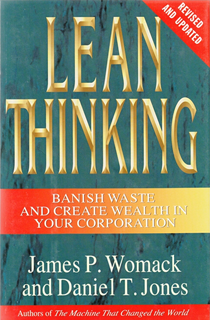
Lean Thinking
In the first of two new chapters, the authors track the trend in inventory turns – the lean metric that cannot lie — across all industries, singling out one industry for special praise. They also return to companies examined in the original book, reexamining the progress at Toyota, Wiremold, Porsche, Lantech, Pratt & Whitney, and Freudenberg-NOK. In this variety of companies and production environments, the authors find that lean thinking is more relevant that ever.
“We discover that as economies have gyrated, stock markets have crashed, and the poster companies of the 1990s hailed in other business books have flown a ballistic trajectory, our lean exemplars – led by Toyota – have defied the fate of most firms featured in successful business books,” observe the authors. “They have continued their methodical march from success to success and have done it the hard way by creating real and truly sustainable value for their customers, their employees, and their owners.”
In the second new chapter, the authors share what they themselves have learned about lean thinking and its successful application. For example, in updating the implementation Action Plan from the first edition, they add significant insights into the steps on value-stream mapping and spreading lean thinking to customers and suppliers. And they walk readers through “lean math,” a simple, new way to calculate whether moving from high-cost to low-cost regions really delivers the anticipated payoffs.
The Action Plan helps the reader develop and implement a lean conversion plan. It draws upon the experiences of the authors, as well as leading lean professionals. It breaks down the theory into real nuts-and-bolts language, because lean conversion is more than just techniques — it’s about changing mindsets to identify and eliminate waste.
New readers will discover that Lean Thinking is as relevant to solving their business problems today as it was when first published. A follow-up to the bestseller, The Machine That Changed the World, Lean Thinking revealed to executives and managers the benefits of lean manufacturing, so they can champion the lean transformation.
New readers will discover that Lean Thinking is as relevant to solving their business problems today as it was when first published. A follow-up to the bestseller, The Machine That Changed the World, Lean Thinking revealed to executives and managers the benefits of lean manufacturing, so they can champion the lean transformation.
Written in a straightforward style, the book describes the main concepts of lean and gives specific manufacturing examples. Authors, James Womack and Daniel Jones, interview key people and examine the lean conversions in a step-by-step manner. In the process, they explore the obstacles each organization overcame to reap the benefits of lean production.
The authors use case studies from a wide range of industries, to distill out the essential principles of lean and explain how to apply them in a variety of environments. They illustrate that lean is not just another buzzword or a quick fix. Lean Thinking definitively shows that it is a new way of thinking and a new way for running companies with benefits for everyone from the line worker to the CEO.
The ultimate goal, according to the authors, is the reduction of waste. To achieve this, a company must look at what creates value and eliminate all other activities.
